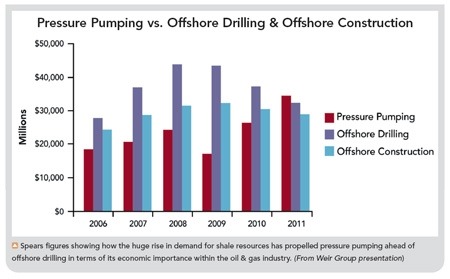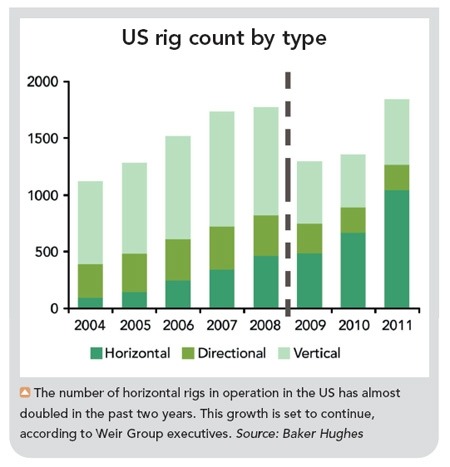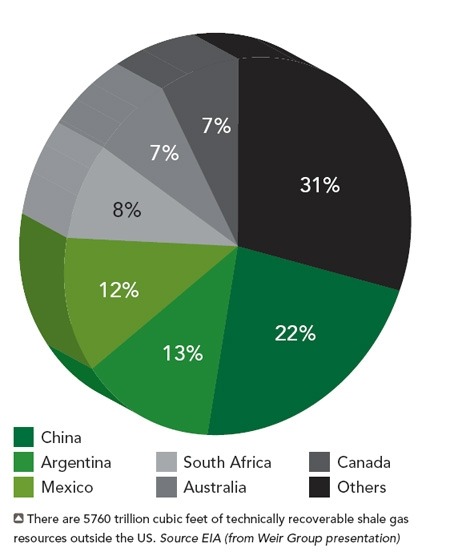Shale holds much promise for equipment makers
1 Jan 2012
The continuing expansion of shale gas production in the US and its likely spread to other locations around the world offers major opportunities for manufacturers of pressure pumping and related hydraulic fracturing (fracking) equipment.
Pressure pumping is the largest and fastest growing upstream oilfield market in the world, according to Richard Spears, managing director of US-based Spears & Associates. The market is currently concentrated in North America because most wells are drilled there, providing about 75% of the frack demand.
Of the 90,000 new wells drilled in the world in 2011, 16,000 are horizontal wells drilled on land in the US and they drive most of the demand for fracking services, continued Spears. However, he added, fracking activity is growing in all regions and should double internationally over the next 10 years.
There has been a “paradigm shift” in pressure pumping since the emergence of shale gas extraction via hydraulic fracturing and horizontal drilling, according to the Weir Group, which supplies pressure pumping and related equipment and services to the sector.
“Technologies such as multi-stage fracturing and fracture mapping have also helped make shale oil recovery more economical.” said the Glasgow-headquartered group, which serves the market from two Texas-based businesses - Weir SPM, Fort Worth and Weir Mesa, Odessa.
“Over the past two years, improved economics - with the emergence of oiland liquid-rich shale and increased demand - has seen the number of horizontal rigs nearly double,” said Steven Noon, managing director of Weir’s oil & gas division.
In North America, Noon sees a continuing rise in horizontal rig counts supported by oiland liquid-rich shale. Accelerating operational intensity there will lead also to increasing stages and increasing horsepower requirements, as well as shorter recertification and replacement cycles.
Operating environments are becoming more severe and variable, causing greater wear on equipment and increased service requirements, according to Spears. Equipment, he said, is now being driven around the clock, with 20% of pumps having to be replaced each year.

In the Marcellus shale development, for example, the number of stages per rig rose nearly 40% to 194 between 2008 and 2011, while the horsepower requirement per rig increased almost six-fold. This higher operating intensity has reduced average pump life to four-to-five years, from six-to-seven years in 2008, according to Gavin Nicol, president of Weir SPM.
The consequent unpredictability of product life will increase demand for technical assistance, including support from suppliers on site, Nicol said. He expects the aftermarket to grow at 20% a year to 2013, and parts replacement to account for over 50% of the market.
As well as North America, Weir sees good, long-term opportunities from vast international shale gas resources, which are estimated to be six to seven times greater than US reserves. China is the leading international prospect over the next five years, though the UK group is also targeting developments in Poland and Argentina.
Weir bosses also take an upbeat view of the continuing environmental debate around possible leakage of frack fluids into the water table and disposal of wastewater.
In the UK, a report by the Energy & Climate Change committee was broadly supportive of fracking, said Noon. Meanwhile, he added, US regulatory moves to minimise the environmental risks of fracking are likely to increase demand for better well-casing integrity, as well as for products for the disposal of frack fluids.
The increasingly severe operating conditions, meanwhile, are driving demand for safety products such as nitrogen relief valves that provide over-pressure protection during high pressure pumping.
In response to these trends, Weir introduced a 2,500hp triplex frack pump, which is designed for the harsh environments of unconventional gas formations. It has a 10-inch stroke producing fewer cycles for the same amount of flow rate as an 8-inch stroke pump - fewer duty cycles means less wear on components and better durability, plus an increased operating range for the entire pump.
Other introductions include an enhanced range of flow-line check valves and new additions to its range of flow-line safety restraints, plus the application of electronic sensors to indicate actuation of safety relief valves
The group is currently planning to introduce a five-cylinder frack pump and a range of flow-line products rated to an “industry-first” 30,000psi. It is also set to launch technology for tracking and recertifying flow-line equipment, together with a range of enhanced safety relief valves.








